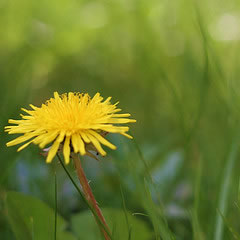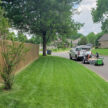
Carrying out preventative health care for your lawn, just as you would for your body, will build it into a healthy lawn that can fend off attacks from most weeds and pests. The following are some important, yet simple preventative lawn care maintenance tips.
Preventative Lawn Care Tip #1: Choose the Right Grass Type for Your Area

Grass that is well adapted for your area will grow better and resist local disease and pests better. There are new varieties of grass every year. To find the best grass for your area, contact your county extension agent: http://www.csrees.usda.gov/Extension/.
Remember grass doesn’t grow well everywhere
Don’t waste your time fighting it if the grass doesn’t grow well in all spots of your yard. For example, under a spruce tree, decorative mulch or shade-loving plants that are tolerant of acidic soils can be a better choice.
Preventative Lawn Care Tip #2: Water Your Lawn Slowly, Deeply and Less Frequently
Proper watering will allow your grass to grow deeper roots making it less vulnerable to drought. Water early in the morning to avoid moisture loss through evaporation. Water deeply and infrequently to establish deep roots and a healthier lawn that can resist weeds and disease. No established lawn should require daily watering.
Preventative Lawn Care Tip #3: Develop Healthy Soil for Your Lawn
Improve the texture of your soil.
Grass grows best in intermediate soils with a good mix of clay, silt, and sand. Try using compost materials and/or mulching your grass clippings to improve soil texture and recycle nitrogen into the soil.
Aerate once a year.
Aeration makes more space for grassroots to spread. It also increases the effectiveness of the lawn treatment by aiding in absorption. The fertilizer sits in the holes and is then absorbed through the soil as opposed to running off. Aeration may be necessary if you have high clay content in your soil or heavy traffic in your yard.
Use locally produced organic fertilizers.
Many lawns need additional nitrogen, phosphorus or potassium. Use locally produced organic fertilizers as they are healthier for your pets, children and the waterways. Significantly fewer resources are used to produce local organic fertilizers. These products work within nature’s cycles rather than altering them. If necessary, synthetic fertilizers can offer quick results while you start your program of organic fertilization which will lead to healthier grass over the long haul.
Make sure you have the right soil pH.
Grass absorbs nutrients most efficiently in slightly acid soil with a pH of 6.5 to 7.0. Lime can be added to soil that is too acidic or sulfur if the soil is not acidic enough. Inexpensive soil analysis kits can be purchased at lawn & garden stores.
Sprinkle a thin layer of compost or topsoil.
Thatch is a layer of dead plant material between the grass and the soil. If thatch is deeper than 1/2 inch thick, it can prevent water and nutrients from reaching the soil and roots of your grass. The overuse of fertilizer can create a thick layer of thatch. Sprinkling a thin layer of compost or topsoil over the lawn or raking can reduce thatch and increase the health of the soil and lawn.
Preventative Lawn Care Tip #4: Avoid or Cautiously Use Pesticides to Treat Your Lawn
 Pesticides include insecticides, herbicides, and fungicides. Before using any pesticides, it’s important to understand that all pesticides are toxic to some degree and can harm your children, wildlife and your pets. Pesticides can also kill beneficial organisms including worms, disrupting the ecological balance in your yard. Pests may be due to any underlying problem in your yard, so make sure you understand the problem before applying a synthetic product. Consider your options carefully; biological controls such as ladybugs to control aphids may be a good solution. If you feel pesticides are necessary, use spot treatment instead of blanket application to the entire yard.
Pesticides include insecticides, herbicides, and fungicides. Before using any pesticides, it’s important to understand that all pesticides are toxic to some degree and can harm your children, wildlife and your pets. Pesticides can also kill beneficial organisms including worms, disrupting the ecological balance in your yard. Pests may be due to any underlying problem in your yard, so make sure you understand the problem before applying a synthetic product. Consider your options carefully; biological controls such as ladybugs to control aphids may be a good solution. If you feel pesticides are necessary, use spot treatment instead of blanket application to the entire yard.
Avoiding or limiting pesticides is an important part of preventative lawn care
Preventative Lawn Care Tip #5: Be Realistic About Weeds
Even a healthy lawn will have some weeds. If you kill off every single weed, you are also killing off beneficial insects and organisms that work to keep your lawn healthy. A lawn with 15% weeds can look practically weed-free to the average observer.
Think before you act
 Cut out or pull weeds occasionally. If your lawn is overrun with weeds, look for underlying causes to come up with a long-term solution related to your soil conditions, mowing or watering. Short-term fixes such as pesticides, herbicides, and synthetic fertilizers will only yield short term gains but can leave the environment with long‐term problems. If weeds become a problem, we recommend using organic weed control by using a natural weed killer. If you’re not sure where to start, get in touch with your local Clean Air Lawn Care franchise owner. They can help you build a preventative lawn care plan and then execute it with perfection.
Cut out or pull weeds occasionally. If your lawn is overrun with weeds, look for underlying causes to come up with a long-term solution related to your soil conditions, mowing or watering. Short-term fixes such as pesticides, herbicides, and synthetic fertilizers will only yield short term gains but can leave the environment with long‐term problems. If weeds become a problem, we recommend using organic weed control by using a natural weed killer. If you’re not sure where to start, get in touch with your local Clean Air Lawn Care franchise owner. They can help you build a preventative lawn care plan and then execute it with perfection.
Sustainable & Organic Lawn Care Does Make a Difference
Your yard may seem like a small plot, but the choices that you and your neighbors make have a great impact on our environment as a whole. Each weekend about 54 million Americans mow their lawns; and the way we care for our lawns ads up.
Try “greener” lawn care ‐ for the health of your family and for the health of our environment.
Are You Interested in Getting Help with Preventative Lawn Care?
If so, please contact Clean Air Lawn Care for a lawn care estimate or to enquire about lawn care franchise opportunities in your area.
Tags: Aeration, Compost, Lawn Watering, Natural Pesticides, Natural Weed Killer, Organic Fertilizer, Organic Lawn Care, Organic Pesticides, Organic Weed Control, Organic Weed Killer, Soil pH





